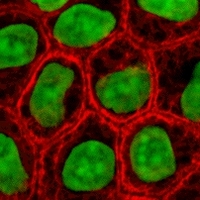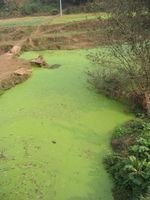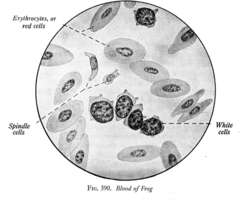 1 Cells are a part of every living thing. Just like atoms are the building blocks of matter, cells are the building blocks of living things. Some living things are made of only one cell. Most of the germs that can make us sick are made of only a single cell. Other living things are made of many, many cells. Trillions of cells come together to build a human being!
1 Cells are a part of every living thing. Just like atoms are the building blocks of matter, cells are the building blocks of living things. Some living things are made of only one cell. Most of the germs that can make us sick are made of only a single cell. Other living things are made of many, many cells. Trillions of cells come together to build a human being! Copyright © 2011 edHelper
Assignment=Please copy this graphic organizer and complete it in your journal from the reading above.

Assignment= Please copy this quiz into your journal and complete it there.
| _____________________________ |  | Date ___________________ |
|
|
|
| ||||
|
|
Cells
The amoeba is a tiny, one-celled organism. You need a microscope to see most amoebas - the largest are only about 1 mm across. Amoebas live in fresh water (like puddles and ponds), in salt water, in wet soil, and in animals (including people). There are many different types of amoebas. The name amoeba comes from the Greek word amoibe, which means change. (Amoeba is sometimes spelled ameba.)
Anatomy: An amoeba consists of a single blobby cell surrounded by a porous cell membrane. The amoeba "breathes" using this membrane - oxygen gas from the water passes in to the amoeba through the cell membrane and carbon dioxide gas leaves through it. A complex, jelly-like series of folded membranes called cytoplasm fills most of the cell. A large, disk-shaped nucleus within the amoeba controls the growth and reproduction of the amoeba.
Diet: Amoebas eat algae, bacteria, plant cells, and microscopic protozoa and metazoa - some amoebas are parasites. They eat by surrounding tiny particles of food with pseudopods, forming a bubble-like food vacuole. The food vacuole digests the food. Wastes and excess water are transported outside the cell by contractile vacuoles.
Locomotion: Amoebas move by changing the shape of their body, forming pseudopods (temporary foot-like structures). The word pseudopod means "false foot."
Reproduction: Amoebas reproduce asexually by binary fission. A parent cell divides (the nucleus also divides in a process called fission) and produces two smaller copies of itself.
Classification: Eukaryota (organisms with nucleated cells), Kingdom Protista (flagellates, amoebae, algae, and parasitic protists), Phylum Protozoa (single-celled organisms), Class Sarcodina (having pseudopods).Copyright ©2001-2010 EnchantedLearning.com ------ How to cite a web page
Assignment=Please copy this graphic organizer and complete it in your journal from the reading above.

VERY COOL LESSON
Objective(s):
Grade Level: Middle/ Upper Level -Elementary School
Periods: 4-40 minutes
To observe the wealth of living organisms in a drop of water from our freshwater ecosystems
To classify the types of organisms observed as single-celled or multi-cellular
Use a key or chart to identify and name the organisms found
Background:
Ecologists divide freshwater ecosystems into bodies of running water and bodies of standing water. In the latter the current slows and most suspended particles settle to the bottom. Lakes and ponds are bodies of standing water that will serve as the sources for water samples to investigate freshwater ecosystems.
Protists, which comprise many of the organisms found in the water samples, are mostly single-celled microscopic organisms. They have a nucleus and other cell parts. There are three groups of protists: protozoans (animal-like protists), algae (plant-like protists), and fungi.
Materials:
Pond water, lake water, microscopes, slides, cover slips, droppers, paper towels, small dishes, key of freshwater microorganisms (obtained from a book such as one of the references listed below)
Strategy:
- Teacher will collect enough pond/lake water in order for each student to have his/her own sample.
- Review usage and handling of a microscope during period 1.
- Explain the steps for preparing a slide (period 1). Each student will be required to prepare a slide using the water sample(s). Place a drop of water on the slide and cover with coverslip, make sure no air bubbles are present.
- Observe the slide under the low power objective lens and search for protists. Watch also for movement.
- When you find some protists that are not moving or moving slowly switch to the high power objective lens.
- Draw your protists within circles (about 8 cm in diameter) drawn on sheets of paper.
- Note the eyepiece and objective lens magnifications and calculate total magnification. This is the eyepiece magnification times the magnification of the objective lens (both should be marked right on the lenses).
NOTE: Pond water can be simulated by preparing a culture of hay infusion. Method: Fill a large jar about two-thirds full of tap water. Let it stand uncovered for three or four days so that air can dissolve in it. Cut some hay or dried grass into short pieces and drop two handfuls into the water. Cover the jar and allow the culture to incubate about two weeks. When the culture is ready, examine several drops taken from different parts of the jar.
Performance Assessment:
Draw and label living organism observed under the microscope.
Use the key to identify and group organism(s) found in the water samples.
Conclusions:
With all life, irrespective of scale, there is a continual struggle and competition for survival. A pond is a miniature cosmos. A diverse range of living forms, both animal and plant, compete for energy supplies, food, space, and other resources.
Assignment= Please copy this quiz into your journal and complete it there. Cells By Brandi Waters |
Directions: Fill in each blank with the word that best completes the reading comprehension.
 Cells are a part of every living(1) _______________________ . Just like atoms are the(2) _______________________ blocks of(3) _______________________ , cells are the building blocks of living things. Some living things are made of only one cell. Most of the germs that can make us sick are made of only a(4) _______________________ cell. (5) _______________________ living things are made of many, many cells. Trillions of cells come together to (6) _______________________ a human being!
Cells are a part of every living(1) _______________________ . Just like atoms are the(2) _______________________ blocks of(3) _______________________ , cells are the building blocks of living things. Some living things are made of only one cell. Most of the germs that can make us sick are made of only a(4) _______________________ cell. (5) _______________________ living things are made of many, many cells. Trillions of cells come together to (6) _______________________ a human being!Most cells are very small. They are so small that you cannot see them without a microscope. There are a few cells, though, that are big enough to easily see. An egg, like you might eat for breakfast, is one very(7) _______________________ (8) _______________________ .
There are many different kinds of cells. Plant cells are(9) _______________________ from the cells of animals. Some cells are(10) _______________________ . Some cells work together to(11) _______________________ a job. Some cells can(12) _______________________ . Some cells can glow in the dark! Each type of cell is different, but there are some(13) _______________________ that all cells have in common. All cells are covered by a membrane that helps to protect the cell and hold it together. All cells are (14) _______________________ to(15) _______________________ . All (16) _______________________ can take in nutrients and turn them into (17) _______________________ . All cells respond to changes inside and around them. Cells are(18) _______________________ !
Copyright © 2011 edHelper
Assignment= Please copy this quiz into your journal and complete it there.
 |
|
|
|
| ||||
|
|
Bacteria
Bacteria are microscopic (very tiny) organisms that are unicellular (made up of a single cell). Bacterium is the term for a single bacteria.
Evolution of Bacteria: These primitive organisms were among the first to appear on Earth; bacteria evolved roughly 3.5 billion years ago. The oldest-known fossils are those of bacteria-like organisms.
Discovery of Bacteria: Bacteria were unknown to people until the 1600s, when Antony van Leeuwenhoek first observed them in his newly-made microscope.
Cells of Bacteria: The cells of bacteria are different from those of plants and animals in many ways, the most obvious of which is that bacteria lack a nucleus and other membrane-bound organelles (except ribosomes). Unlike animals and plants, bacteria have pili, flagella, and most have a cell capsule.
Assignment=Please copy this graphic organizer and complete it in your journal from the reading above.
Bacterial cells include the following:
capsule - A layer on the outside of the cell wall. Most but not all bacteria have a capsule.
cell wall - A thin membrane located outside the plasma membrane and within the capsule.
DNA - The genetic material of the bacterium; it is located within the cytoplasm.
cytoplasm - The jellylike material inside the plasma membrane in which the genetic material and ribosomes are located.
flagellum - A long whip-like structure used for locomotion (movement). Some bacteria have more than one flagellum.
pili - (singular is pilus) Hair-like projections that allow bacterial cells to stick to surfaces and transfer DNA to one another.
plasma membrane - A permeable membrane located within the cell wall. It serves many functions for the cell, including energy generation and transport of chemicals .
ribosomes - Small organelles composed of RNA-rich granules that are sites of protein synthesis. The ribosomes are located within the cytoplasm.
Diet: Bacteria have a wide range of diets. Some are heterotrophs (they eat other organisms) and others are autotrophs (they make their own food)
Where are Bacteria Found: Bacteria are found almost everywhere on Earth, including in the seas and lakes, on all continents (including Antarctica), in thesoil, and in tissues of plants and animals.
Assignment=Please copy this graphic organizer and complete it in your journal from the reading above.

 |
| 1. | cell, large, different, move |
| 2. | without, turn, plant, microscope, easily |
Please Read This Article
| Algae, Our Oxygen Suppliers By Cindy Grigg |  |
 1 Algae are tiny plant-like living things. Some algae live on land. They grow with lichens on rocks. Most algae live in water. At one time, algae were thought to be plants. But they are different from plants. Algae don't have roots, stems, or true leaves. Algae do have chlorophyll. Like plants, they use sunlight to make their own food. In the process, they make oxygen.
1 Algae are tiny plant-like living things. Some algae live on land. They grow with lichens on rocks. Most algae live in water. At one time, algae were thought to be plants. But they are different from plants. Algae don't have roots, stems, or true leaves. Algae do have chlorophyll. Like plants, they use sunlight to make their own food. In the process, they make oxygen.2 Did you know that most of our oxygen is made by algae? How can this be? You might ask what about trees and other land plants? But remember that oceans cover about 71% of the Earth. Land only makes up about 29% of Earth's surface. Also remember that there are large chunks of land that don't have many plants at all. Antarctica and many large deserts have few plants growing there. Experts say that about 70 to 80 percent of our oxygen comes from algae! Some people think that algae are the most important living things on Earth!
Assignment=Please copy this graphic organizer and complete it in your journal from the reading above.

3 Algae can be only one cell. Some algae are made of many cells. Most algae get their name from the color they appear. There are three main kinds: brown, red, and green algae. In freshwater ponds and lakes, the most common kind is green algae. Green algae grow on or near the surface where there's plenty of sunlight. The green color comes from chlorophyll.
4 In the ocean, though, most algae are the brown kind. Red algae mostly live in deeper water where there is less sunlight. Since algae are so small, you don't see them when you look at the ocean. But don't forget they're in there! Next time you breathe in, thank the algae!
Copyright © 2011 edHelper
Assignment=Please copy this graphic organizer and complete it in your journal from the reading above.
Assignment= Copy these questions and your answers in your journal
 | Date ___________________ |
|
| ||||
|
| ||||
|
 |
Algae, Our Oxygen Suppliers
Assignment: Watch the video that is in the middle of the title. Click the arrow and then take between 5-20 notes from the movie in your journal.
| Algae, Our Oxygen Suppliers By Cindy Grigg |  |
Directions: Copy and put in journal.
Then fill in each blank with the word that best completes the reading comprehension.
 Algae are tiny plant-like (1) _______________________ things. Some algae live on land. They grow with lichens on rocks. Most algae live in water. At one time, algae were thought to be plants. But they are different from plants. Algae don't have (2) _______________________ , stems, or(3) _______________________ leaves. Algae do have (4) _______________________ . Like plants, they use sunlight to make their own food. In the (5) _______________________ , they make oxygen.
Algae are tiny plant-like (1) _______________________ things. Some algae live on land. They grow with lichens on rocks. Most algae live in water. At one time, algae were thought to be plants. But they are different from plants. Algae don't have (2) _______________________ , stems, or(3) _______________________ leaves. Algae do have (4) _______________________ . Like plants, they use sunlight to make their own food. In the (5) _______________________ , they make oxygen.Did you know that most of our oxygen is made by algae? How can this be? You might ask what about trees and other land plants? But (6) _______________________ that (7) _______________________ cover about 71% of the Earth. Land only makes up about 29% of Earth's surface. Also remember that there are (8) _______________________ chunks of land that don't have many plants at all. Antarctica and many large(9) _______________________ have few plants growing there. Experts say that about 70 to 80 percent of our oxygen comes from algae! Some people think that algae are the most important living things on Earth!
Algae can be only one (10) _______________________ . Some algae are made of many(11) _______________________ . Most algae get their name from the color they appear. There are three main kinds: brown, red, and green algae. In freshwater ponds and lakes, the most common kind is green algae. Green algae grow on or(12) _______________________ the surface where there's plenty of sunlight. The green color comes from chlorophyll.
In the (13) _______________________ , (14) _______________________ , most algae are the brown kind. Red algae mostly live in deeper (15) _______________________ where there is less sunlight. Since algae are so small, you don't see them when you look at the ocean. But don't (16) _______________________ they're in there! Next(17) _______________________ you breathe in, thank the algae!
Copyright © 2011 edHelper
Assignment= Please copy this quiz into your journal and complete it there.
 |
|
| ||||
|
|
 |
|
| 1. | ___ ___ ___ ___ ___ + ___ ___ + ___ ___ ___ | ||||||||||||||||||||||||||||||||||||||||||||||||||||||||||||||||||||||||||||||||||||||||||||||||||||||||||||||||||||||||||||||||||||||||||||||||||||||
| 2. | ___ ___ ___ ___ ___ ___ ___ | ||||||||||||||||||||||||||||||||||||||||||||||||||||||||||||||||||||||||||||||||||||||||||||||||||||||||||||||||||||||||||||||||||||||||||||||||||||||
| 3. | ___ ___ ___ + ___ ___ ___ ___ | ||||||||||||||||||||||||||||||||||||||||||||||||||||||||||||||||||||||||||||||||||||||||||||||||||||||||||||||||||||||||||||||||||||||||||||||||||||||
| 4. | ___ ___ ___ ___ ___ | ||||||||||||||||||||||||||||||||||||||||||||||||||||||||||||||||||||||||||||||||||||||||||||||||||||||||||||||||||||||||||||||||||||||||||||||||||||||
| 5. | ___ ___ ___ ___ | ||||||||||||||||||||||||||||||||||||||||||||||||||||||||||||||||||||||||||||||||||||||||||||||||||||||||||||||||||||||||||||||||||||||||||||||||||||||
| 6. | ___ ___ ___ + ___ ___ ___ ___ | ||||||||||||||||||||||||||||||||||||||||||||||||||||||||||||||||||||||||||||||||||||||||||||||||||||||||||||||||||||||||||||||||||||||||||||||||||||||
| 7. | ___ ___ ___ + ___ ___ | ||||||||||||||||||||||||||||||||||||||||||||||||||||||||||||||||||||||||||||||||||||||||||||||||||||||||||||||||||||||||||||||||||||||||||||||||||||||
| 8. | ___ ___ ___ ___ | ||||||||||||||||||||||||||||||||||||||||||||||||||||||||||||||||||||||||||||||||||||||||||||||||||||||||||||||||||||||||||||||||||||||||||||||||||||||
| 9. | ___ ___ ___ ___ ___ ___ | ||||||||||||||||||||||||||||||||||||||||||||||||||||||||||||||||||||||||||||||||||||||||||||||||||||||||||||||||||||||||||||||||||||||||||||||||||||||
| 10. | ___ ___ + ___ ___ ___ + ___ ___ ___ ___ | ||||||||||||||||||||||||||||||||||||||||||||||||||||||||||||||||||||||||||||||||||||||||||||||||||||||||||||||||||||||||||||||||||||||||||||||||||||||
| 11. | ___ ___ ___ ___ ___ | ||||||||||||||||||||||||||||||||||||||||||||||||||||||||||||||||||||||||||||||||||||||||||||||||||||||||||||||||||||||||||||||||||||||||||||||||||||||
| 12. | ___ ___ ___ ___ + ___ ___ | ||||||||||||||||||||||||||||||||||||||||||||||||||||||||||||||||||||||||||||||||||||||||||||||||||||||||||||||||||||||||||||||||||||||||||||||||||||||
| Assignment: Watch the video that is to the right. Click the arrow and then take between 5-20 notes from the movie in your journal. 13. | ___ ___ ___ + ___ ___
 1 Caption: Frog blood cells; the white blood cells are the round, dark ones in the center of the picture. 1 Caption: Frog blood cells; the white blood cells are the round, dark ones in the center of the picture.2 Red blood cells give your blood its red color. They carry oxygen from your lungs to all of the cells in your body. However, there is more to your blood than just red blood cells. More than half of your blood is made up of a liquid called plasma. It is mostly water, but it is very important. Plasma helps your blood to flow. It allows your heart to pump your blood through your blood vessels. Red blood cells make up most of the remaining part of your blood, but there are other important blood components. One of these is white blood cells. 3 White blood cells may seem a little out of place in your blood. They have little in common with red blood cells. Their job has nothing to do with the heart or blood vessels. White blood cells are like soldiers. Their job is to protect you from invaders. White blood cells fight germs that try to enter your body. Germs can get into your body through the air that you breathe and through the things that you eat or drink. They can also get into your body through a cut on your skin. White blood cells are always looking out for germs. If they find a germ (or many germs), they can call for help and more white blood cells will come to help. If there is an accident and you have a cut, white blood cells can also help to prevent germs from getting inside your body. They move quickly to the area that is hurt. They help keep the area clean, help your body to heal, and kill germs. 4 Normally, there are not very many white blood cells in your blood. If you need them, your body can make more. If you get a small cut on your knee, you will need a few more white blood cells to help the cut heal and to kill germs. If you get sick with the flu, you will need a lot more white blood cells. After the threat has passed, some white blood cells can remember what the invader looked like. These white blood cells can react very quickly if that type of germ ever returns. They can act so quickly that they can kill the germ before it can make you sick! Copyright © 2011 edHelper Assignment= Please copy this quiz into your journal and complete it there.
Directions: Assignment= Please copy this quiz into your journal and complete it there. Fill in each blank with the word that best completes the reading comprehension.  Caption: Frog blood cells; the white blood cells are the round, dark ones in the center of the picture. Caption: Frog blood cells; the white blood cells are the round, dark ones in the center of the picture.Red blood cells give your blood its red color. They carry oxygen from your lungs to all of the cells in your body. However, there is more to your blood than just red blood cells. More than (1) _______________________ of your blood is made up of a liquid called plasma. It is mostly (2) _______________________ , but it is very important. Plasma helps your(3) _______________________ to flow. It allows your heart to(4) _______________________ your blood through your blood vessels. Red blood cells make up most of the remaining part of your blood, but there are other important blood components. One of these is white blood cells. White blood cells may seem a little out of (5) _______________________ in your blood. They have little in(6) _______________________ with red blood cells. Their job has (7) _______________________ to do with the heart or blood vessels. White blood cells are like soldiers. Their job is to protect you from (8) _______________________ . White blood cells fight germs that try to enter your body. Germs can get into your body through the air that you breathe and(9) _______________________ the things that you eat or drink. They can also get into your body through a cut on your skin. White blood cells are always looking out for germs. If they find a germ (or many germs), they can call for help and more white blood cells will come to help. If there is an (10) _______________________ and you have a cut, white blood cells can(11) _______________________ help to prevent germs from getting inside your body. They(12) _______________________ quickly to the area that is hurt. They help keep the area clean, help your body to heal, and kill germs. Normally, there are not very many white blood cells in your blood. If you need them, your body can make more. If you get a small cut on your (13) _______________________ , you will need a few more white blood cells to help the cut heal and to kill germs. If you get sick with the flu, you will need a lot more white blood cells. After the threat has passed, some white blood cells can remember what the invader looked like. These white blood cells can react very quickly if that type of germ ever returns. They can act so quickly that they can (14) _______________________ the germ before it can make you sick! Copyright © 2011 edHelper Assignment= Please copy this quiz into your journal and complete it there.
|
Assignment: Watch these 2 videos that are below Click the arrows and then take between 5-20 notes from the movies in your journal.







Good write-up, I'm normal visitor of one's blog, maintain up the nice operate, and It's going to be a regular visitor for a lengthy time.
ReplyDeleteBuddy Products Three Tier Medical File Folder Cart, Steel, 16 x 38.75 x 26 Inches, Platinum (5428-32)